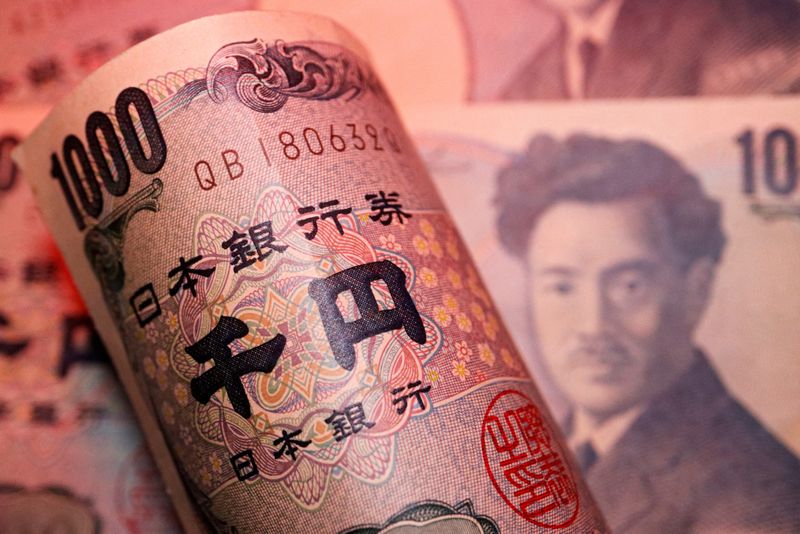Analysis-A stronger yen could jolt global markets
2023.04.27 03:05

© Reuters. Banknotes of Japanese yen are seen in this illustration picture taken September 22, 2022. REUTERS/Florence Lo/Illustration
By Naomi Rovnick, Amanda Cooper and Harry Robertson
LONDON (Reuters) – Investors are positioning for a regime change in global markets as the Bank of Japan edges closer to ditching the policies that depressed the yen for decades, thereby luring Japanese money back home.
The BOJ, by flooding its financial system with cheap cash and keeping interest rates below zero for years, turned its currency into the ideal funding vehicle and sent trillions of dollars of Japanese cash overseas in search of better returns.
It is now the last holdout in the global race to raise rates, but with Japanese inflation at multi-decade highs, the yen has steadily strengthened.
That means portfolio managers are having to factor a stronger yen into global stock selection in way they have not for years, with some even anticipating mergers and acquisitions as the Japanese market revs up.
“The trigger for the revaluation of the Japanese markets is higher rates and then a stronger yen. It’s a market that has been undervalued for years and years and has been a value trap,” said Carmignac’s head of cross-asset Frederic Leroux. (Graphic: Japanese investors’ overseas holdings,
The yen has gained moe than 11% from 30-year lows against the dollar hit last October, and roughly 9% from eight-year lows hit against Australia’s currency last year.
Kazuo Ueda, who concludes his first two-day meeting as BOJ chief on Friday, has stressed the need for ultra-loose monetary policy but also signalled the chance of raising rates to tame inflation.
Others expected more money to leave major bond markets that long offered far better yields than Japanese peers as expectations for a policy shift rise.
“We are about to see a repatriation of assets back into Japan, and the numbers are really quite big,” said Sam Perry, a senior investment manager at Pictet Asset Management. “This reversal could be really quite dramatic.”
Japan’s insurers and pension funds alone hold $1.84 trillion in foreign assets, Deutsche Bank (ETR:) calculates, greater than the size of South Korea’s economy.
Japanese investors are the largest overseas holders of U.S. Treasuries.
With Japanese inflation is at its highest in four decades, excluding energy, the BoJ may consider ending its yield curve control (YCC) policy – through which it keeps long-term interest rates ultra-low by buying Japanese government bonds (JGBs) – sometime this year.
Some market watchers think that might even happen this week.
“Policy normalisation could turn back the clock for Japanese investors,” Deutsche Bank strategists said in a note. “This is a once-in-a-generation regime shift.” (Graphic: How the Yen has moved,
LONG YEN? TRY STOCKS
Citi strategists have put a target on the Japanese yen of 125 per dollar, compared to 134 now, but also expect the currency to strengthen further from this target over time.
Prospects of a consumer spending splurge in Japan, where decades of deflation have influenced people to save money and wait for products to become cheaper, are sparking interest in a long-neglected stock market.
Carmignac’s Leroux said that due to Japan’s ageing population and worker shortage, inflation’s recent comeback may boost wages and therefore consumption.
A stronger yen would boost households’ power to buy imported goods, he added, all combining to potentially jump-start the economy.
Tokyo’s has traded at a discount to the for nine years. Its price-to-earnings ratio now stands at 14.7, compared to 22.7 for the U.S. index.
Carmignac, like many global investors, has maintained an underweight position towards Japanese stocks but, Leroux said, it was looking to raise this to neutral.
DOMINO EFFECT
Japan is a global bond-market heavyweight. Its yield-hungry investors own almost 6% of Australian bonds and 4.1% of French debt, according to Deutsche Bank. Japanese investors also hold more than $1 trillion worth of U.S Treasuries.
But if a big market gets hit, that can have a knock-on effect on smaller ones.
“In the absence of that liquidity you run the risk of the market putting pressure on some of its weaker parts, such as peripheral bonds in the euro zone”, said Wouter Sturkenboom, chief investment strategist for EMEA at Northern Trust (NASDAQ:) Asset Management.
Yet Sturkenboom said he only expected gradual change to the YCC policy.
Japanese investors dumped foreign bonds in 2022. And while that trend flipped in early 2023, Deutsche Bank estimates domestic investors are likely to buy an extra $600 billion worth of domestic bonds once the BoJ steps away from its massive JGB purchases, which have suppressed yields.
Low Japanese rates have made the yen the funding currency of choice for carry trades, in which traders typically borrow a low-yielding currency to then sell and invest the proceeds in assets denominated in a higher-yielding one.
Analysts say the yen is still the ideal carry-trade currency, but Bank of America (NYSE:) research shows the market has not really sold yen to fund carry trades for some time.
“Our conversations with clients also suggest the market is (now) at least neutral on the yen,” the bank said in a note. (Graphic: Japanese investors dumped foreign bonds in 2022,








